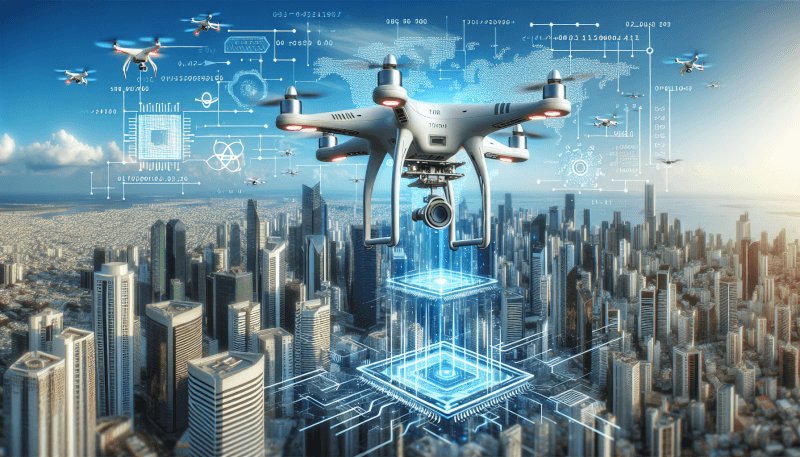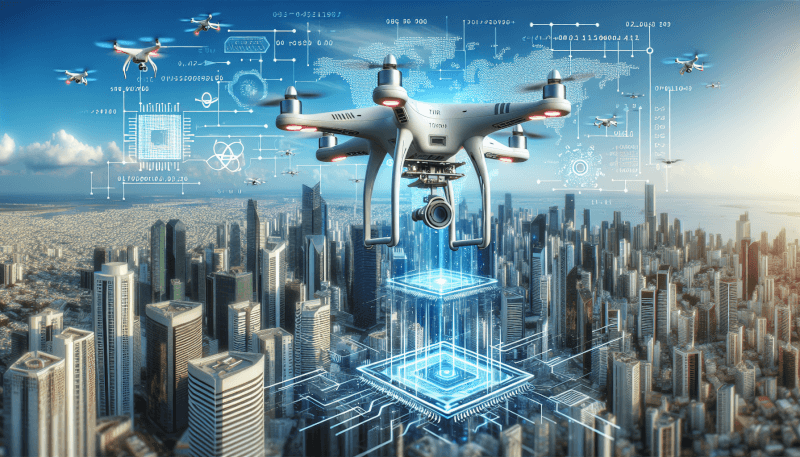Imagine a world where drones can navigate through the sky with unparalleled precision, adapting to their surroundings effortlessly. This is no longer a distant fantasy; artificial intelligence has paved the way for drones to revolutionize the way we perceive and utilize this innovative technology. With the integration of AI, drones are capable of autonomous flight, intelligent obstacle avoidance, and advanced data analysis, transforming various industries such as agriculture, photography, and surveillance. Join us as we explore how artificial intelligence is propelling drone technology into a new era of possibilities.
Enhancing Autonomous Navigation
Drone technology has made significant strides in enhancing autonomous navigation, thanks to advancements in artificial intelligence (AI) systems. Improved collision avoidance systems have been a major focus, allowing drones to fly safely and navigate their surroundings effectively. These systems utilize AI algorithms to detect and avoid obstacles in real-time, providing a safer and more reliable flying experience. With precise mapping and localization capabilities, drones can now accurately determine their position and navigate complex environments with ease. This is achieved through the integration of AI-driven mapping and localization algorithms, which combine sensor data with pre-existing maps to ensure precise navigation. Additionally, advanced path planning algorithms enable drones to efficiently navigate through intricate and dynamic environments, optimizing their flight routes for faster and more efficient travel.
Optimizing Flight Performance
Another area where AI has revolutionized drone technology is in optimizing flight performance. One key aspect is efficient energy consumption, where AI algorithms analyze flight data and adjust the drone’s power usage accordingly, aiming to maximize flight time. This not only extends the drone’s operational lifespan but also allows for longer and more productive flights. Optimal flight routes are also intelligently calculated using AI algorithms, taking into account various factors such as weather conditions, wind patterns, and airspace restrictions. This ensures that drones take the most efficient and safe paths, minimizing travel time and reducing the risk of collisions. Additionally, AI algorithms play a vital role in enhancing stability and maneuverability, compensating for external factors and enabling drones to fly smoothly and maintain their position accurately.

Enhancing Imaging and Sensing Capabilities
Artificial intelligence has greatly enhanced the imaging and sensing capabilities of drones, enabling them to capture and analyze data more effectively. Object recognition and tracking algorithms allow drones to detect and identify objects of interest, such as vehicles, people, or specific landmarks. This technology has various applications, from surveillance to search and rescue missions. Another key area where AI has made significant advancements is improved imaging and resolution. AI algorithms can reconstruct and enhance images captured by drones, improving their clarity and quality. This is particularly beneficial for sectors such as aerial photography, environmental monitoring, and infrastructure inspection. Furthermore, AI-driven sensor fusion algorithms enable drones to integrate data from multiple sensors, enhancing their perception and situational awareness.
Enabling Autonomous Decision Making
Drone autonomy is significantly enhanced by AI systems that enable real-time decision making. With the ability to process vast amounts of data in milliseconds, AI algorithms allow drones to make intelligent decisions at an unprecedented pace. Real-time decision making is crucial in situations where split-second actions can make a significant difference, such as emergency response scenarios. Additionally, automated mission planning algorithms enable drones to execute complex missions efficiently and effectively. By analyzing mission parameters and environmental data, AI algorithms can generate optimized flight plans that consider factors such as time constraints, resource allocation, and risk assessment. This capability has vast implications for various industries, from delivery and logistics to disaster management and search and rescue operations.

Expanding Applications of Drones
The advancements in drone technology and AI have led to the expansion of their applications in various fields. Delivery and logistics is one area where drones have already started making an impact. With autonomous navigation and decision-making capabilities, drones can efficiently and swiftly deliver packages, reducing costs and improving delivery times. Environmental monitoring and conservation have also been revolutionized by drone technology. Drones equipped with advanced sensors and imaging capabilities can collect data on biodiversity, habitat conditions, and environmental changes. This data is crucial for monitoring and conservation efforts, providing valuable insights for researchers and policymakers. Furthermore, drones are increasingly being used for infrastructure inspection, allowing for more efficient and cost-effective assessments of bridges, power lines, and other critical structures.
Enhancing Security and Safety
Drone technology, coupled with AI, has greatly enhanced security and safety initiatives. Surveillance and monitoring capabilities provided by drones have proved invaluable in various industries. Whether it is patrolling borders, monitoring public events, or guarding sensitive facilities, drones equipped with advanced imaging and tracking algorithms can provide real-time intelligence and situational awareness. Risk assessment and threat detection are also significantly improved by AI systems integrated into drones. These systems can analyze sensor data to detect potential threats and anomalies, enabling prompt response and mitigation measures. Additionally, drones play a vital role in disaster management and search and rescue operations, providing aerial views, live-feed data, and remote assistance in critical situations.

Improving Communication and Connectivity
The integration of AI into drones has also improved communication and connectivity capabilities. Drone swarms and collaboration enable multiple drones to work together, sharing data and coordinating their actions. This is particularly beneficial in scenarios such as search and rescue missions or large-scale surveillance operations. Remote control and data transmission have also been streamlined with the help of AI algorithms. Drones can now be controlled remotely with increased precision and reliability, allowing operators to fly them in challenging environments or over long distances. Furthermore, the advent of 5G and beyond promises even faster and more reliable connectivity for drones, further enhancing their capabilities and range of applications.
Challenges and Ethical Considerations
While the advancements in AI-integrated drone technology offer numerous benefits, there are also several challenges and ethical considerations that need to be addressed. Privacy and data security are major concerns, as drones equipped with powerful imaging and tracking capabilities can potentially infringe upon individuals’ privacy rights. Comprehensive regulations and frameworks need to be established to ensure responsible and ethical use of drone technology, protecting the privacy and security of individuals and organizations. Another consideration is the impact on jobs and society. As drones become more capable and autonomous, there is a legitimate concern that certain job roles may become obsolete. It is crucial to balance the implementation of drone technology with measures to reskill and upskill the workforce, ensuring a smooth transition and minimizing negative social impacts.

Future Implications and Possibilities
The integration of drones, AI, and other emerging technologies opens up a world of possibilities and implications for various industries. Integration with the Internet of Things (IoT) and smart cities promises enhanced connectivity and intelligence, enabling drones to seamlessly interact with other devices and infrastructure. This integration can revolutionize sectors such as transportation, urban planning, and public safety. Moreover, the advancements in AI-integrated drone technology pave the way for artificial general intelligence and swarm intelligence. With the ability to learn, adapt, and collaborate, drones can become intelligent entities capable of autonomous decision making and problem-solving at a level comparable to human intelligence. This transformative potential has the power to reshape industries such as agriculture, transportation, and emergency services.
Conclusion
Artificial intelligence is revolutionizing drone technology, enhancing autonomous navigation, optimizing flight performance, enhancing imaging and sensing capabilities, enabling autonomous decision making, expanding applications, enhancing security and safety, improving communication and connectivity, all while addressing challenges and ethical considerations. The future implications and possibilities of this revolution are vast, promising integration with IoT and smart cities, the emergence of artificial general intelligence, and transformative potential in various industries. As AI and drone technology continue to advance, the possibilities for innovation and positive impact are limitless, ushering in a new era of technological progress.



